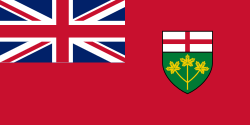Ontario
Ontario is a province of Canada that is in the eastern half of Canada, between Manitoba and Quebec. Ontario has the largest population of any province, with over 16 million in 2025, and is home to the largest city in Canada, Toronto, which is also the capital of the province.
Ontario also has the second-largest land area, with 1,076,395 kilometers; only Quebec is larger by size. (Nunavut and the Northwest Territories are also larger, but are territories, not provinces.) The province has the longest border with the United States. Along the border are four large lakes: Lake Ontario, Lake Erie, Lake Huron, and Lake Superior. All of them are partly in Ontario and partly in the United States, and the border runs through them. However, Lake Michigan is entirely in the United States. These five lakes are together are called the Great Lakes.
A number of symbols represent the province of Ontario. The Ontario flag is red with the British flag in the top left corner, and the provincial shield is on the right hand side of the flag. The provincial bird is the loon, and the provincial flower is the trillium. It has three flower petals and is usually white but sometimes pink or purple.
History
Ontario became part of Canada when they were created in 1867. Before 1840, it was known as Upper Canada, which was a colony in the British Empire. Between 1840 and 1867, it was known as Canada West. The government of Ontario sits at Queen's Park, in Toronto. The leader of the government is called the premier, who is now is Doug Ford. The lieutenant governor represents the Queen, and the current Lieutenant Governor is Edith Dumont.
Geography
Ontario is very large and so people sometimes divide it into Northern Ontario and Southern Ontario. Most of the people in Ontario live in the Southern Ontario, which has the large cities: Toronto and the rest of the Greater Toronto Area, Ottawa and the National Capital Region, Hamilton, London, Windsor, and Sarnia. The cities of Northern Ontario are smaller. In the far north, hardly any people live at all, and there are no roads or railways, which make it difficult even to get to those places.
Much of Ontario gets lots of snow in the winter. In the summer, it can get very hot in the south parts, and in some large cities, there is smog.
Ontario borders the Canadian provinces of Manitoba and Quebec and the U.S. states of Minnesota, Michigan, Ohio, Pennsylvania, and New York.
Ontario Media
- BlackRiver1.JPG
Typical landscape of the Canadian Shield at Queen Elizabeth II Wildlands Provincial Park, located in Central Ontario.
- Ontario Köppen.svg
Köppen climate types of Ontario
- Lake Effect Snow on Earth.jpg
Cold northwesterly wind over the Great Lakes creating lake-effect snow. Lake-effect snow most frequently occurs in the snowbelt regions of the province.
- 1755 Bellin Map of the Great Lakes - Geographicus - GreatLakes-bellin-1755.jpg
A 1755 map of the Pays d'en Haut region of New France, an area that included most of Ontario
- United Empire Loyalist Statue in Hamilton, Ontario.jpg
A monument in Hamilton commemorating the United Empire Loyalists, a group of settlers who fled the United States during or after the American Revolution
- Push on, brave York volunteers(large).jpg
Depiction of the Battle of Queenston Heights, during the War of 1812. Upper Canada was an active theatre of operation during the conflict.
- 1855 Colton Map of Upper Canada or Ontario - Geographicus - Ontario2-colton-1855.jpg
Map of Canada West from 1855. Canada West formed the western portion of the Province of Canada.
- Oliver Mowat.jpg
Oliver Mowat, Premier of Ontario from 1872 to 1896
References
- ↑ Template:Cite cgndb
- ↑ "Population and dwelling counts: Canada, provinces and territories". Statistics Canada. February 9, 2022. Archived from the original on February 9, 2022. Retrieved February 9, 2022.
- ↑ "Population and dwelling counts: Canada, provinces and territories". Statistics Canada. September 2, 2022. Archived from the original on April 11, 2023. Retrieved October 7, 2023.
- ↑ "Population estimates, quarterly". Statistics Canada. September 24, 2025. Retrieved September 24, 2025.
- ↑ "Definition of Ontarian". Collins Online Dictionary. HarperCollins Publishers. Archived from the original on October 4, 2013. Retrieved October 3, 2013.
- ↑ "About Ontario". Ontario.ca. Queen's Printer for Ontario. March 7, 2019. Archived from the original on January 8, 2020. Retrieved January 8, 2020.
- ↑ "Ontario Economic Accounts". Government of Ontario. July 13, 2023. Archived from the original on Apr 14, 2023. Retrieved September 15, 2023.
- ↑ "Sub-national HDI – Subnational HDI – Global Data Lab". Archived from the original on September 25, 2021. Retrieved September 8, 2021.
Other websites
- Wikimedia Atlas of Ontario
- Government of Ontario Archived 2016-03-04 at the Wayback Machine
- Ontario at the Open Directory Project
